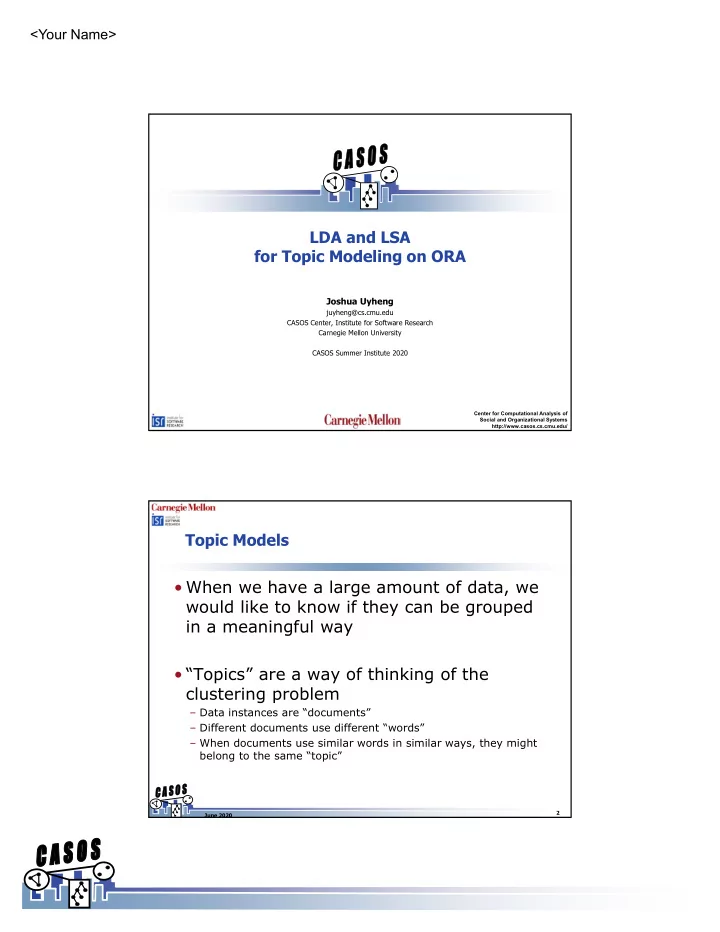

<Your Name> LDA and LSA for Topic Modeling on ORA Joshua Uyheng juyheng@cs.cmu.edu CASOS Center, Institute for Software Research Carnegie Mellon University CASOS Summer Institute 2020 Center for Computational Analysis of Social and Organizational Systems http://www.casos.cs.cmu.edu/ Topic Models • When we have a large amount of data, we would like to know if they can be grouped in a meaningful way • “Topics” are a way of thinking of the clustering problem – Data instances are “documents” – Different documents use different “words” – When documents use similar words in similar ways, they might belong to the same “topic” 2 June 2020 1
<Your Name> Some examples Literal texts More figurative “documents” Dogs like to run and play. Dogs are people’s best friend. Dogs like to chew on bones. Biology is the study of living organisms. Chemistry is the study of matter. Psychology is the study of human behavior and mental processes. One Direction will hold their concert next week. Did you buy the One Direction merchandise? Harry is my favorite One Direction member. 3 June 2020 LSA vs. LDA • Latent Semantic Analysis or Latent Semantic Indexing – Based on matrix factorization – Big difference: You can have negative values • Latent Dirichlet Allocation – Based on probabilistic graphical model – Big difference: Scores expressed as probabilities • Both popular 4 June 2020 2
<Your Name> Latent Semantic Analysis Deerwester, S., Dumais, S. T., Furnas, G. W., Landauer, T. K., & Harshman, R. (1990). Indexing by latent semantic analysis. Journal of the American Society for Information Science, 41(6), 391-407. 5 June 2020 Latent Dirichlet Allocation Blei, D. M., Ng, A. Y., & Jordan, M. I. (2003). Latent dirichlet allocation. Journal of Machine Learning Research, 3, 993-1022. 6 June 2020 3
<Your Name> In practice… • There is no hard and fast way to decide which model is better • A large factor in deciding on the quality and interpretation of a topic model is human judgment • Many will work for general purposes 7 June 2020 In a network setting 1. Documents and words don’t have to be literal documents and words People can serve as “documents” • Hashtags can serve as “words” • Topics can represent tendencies between certain agents to • invoke certain hashtags 2. We can visualize multiple kinds of connections between agents and concepts 8 June 2020 4
<Your Name> Case of NATO Trident Juncture 2018 Uyheng, J., Magelinski, T., Villa-Cox, R., Sowa, C., & Carley, K. M. (2019). Interoperable pipelines for social cyber-security: Assessing Twitter information operations during NATO Trident Juncture 2018. Computational and Mathematical Organization Theory. Advance online publication. 9 June 2020 Topics extracted Uyheng, J., Magelinski, T., Villa-Cox, R., Sowa, C., & Carley, K. M. (2019). Interoperable pipelines for social cyber-security: Assessing Twitter information operations during NATO Trident Juncture 2018. Computational and Mathematical Organization Theory. Advance online publication. 10 June 2020 5
<Your Name> Topics for social cyber-security Uyheng, J., Magelinski, T., Villa-Cox, R., Sowa, C., & Carley, K. M. (2019). Interoperable pipelines for social cyber-security: Assessing Twitter information operations during NATO Trident Juncture 2018. Computational and Mathematical Organization Theory. Advance online publication. 11 June 2020 LDA and LSA for Topic Modeling on ORA Joshua Uyheng juyheng@cs.cmu.edu CASOS Center, Institute for Software Research Carnegie Mellon University CASOS Summer Institute 2020 Center for Computational Analysis of Social and Organizational Systems http://www.casos.cs.cmu.edu/ 6
Recommend
More recommend